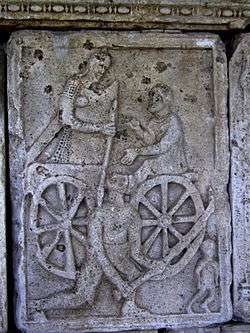Rhomphaia

The Rhomphaia was a close-combat bladed weapon used by the Thracians as early as 400 BC. Rhomphaias were polearms with a straight or slightly curved single-edged blade attached to a pole, which in most cases was considerably shorter than the blade. Although the rhomphaia was similar to the falx, most archaeological evidence suggests that rhomphaias were forged with straight or slightly curved blades, presumably to enable their use as both a thrusting and slashing weapon. The blade was constructed of iron and used a triangular cross section to accommodate the single cutting edge with a tang of rectangular cross section. Length varied, but a typical rhomphaia would have a blade of approximately 60–80 cm and a tang of approximately 50 cm. From the length of the tang, it can be presumed that, when attached to the hilt, this portion of the weapon would be of similar length to the blade.[1]
Usage
Used almost exclusively by the Thracians, examples have been found dating from 300-400 BC. As a weapon, the rhomphaia was feared (like the falx) because of the cutting power afforded to it by the polearm-like design. The falx forced the only documented change in Roman armour brought about by an encounter with a new weapon. After encountering the falx in Dacia, the Romans added extra reinforcing bars to their helmets to protect against the powerful blows of this weapon.
Differences from the falx
The rhomphaia's blade was straight or only slightly curved, while the falx's blade was significantly curved. Because its straighter blade facilitated a thrusting motion, as well as an overhead or sidewards hacking motion, the rhomphaia could be used by tightly packed troops as a defensive weapon. However, the straighter blade limited the use of the cutting edge.
Rhomphaia in historical texts
Rhomphaia was first a "spear", later a "sword" (Plutarch: Life of Aemilius Paulus 18; Eustathius, on Iliad verse VI 166; Hesychius; also Luke 2:35 and the Revelation of John of Patmos, several times.). In Latin, it has the forms:
- rumpia (Livy, Aulus Gellius, Ascon. ad Mil.)
- romphea (Isidore of Seville.),
- romphaea vel romfea (CGL 7, 212).
W. Tomaschek listed the Bulgarian roféja, rufja "thunderbolt" and the Albanian rrufë as derivatives of that word.
Rhomphaia was also preserved in modern Greek as rhomphaia "big broad sword". The Thracian rhomphaia contains the stem *rump- in the Latin rumpo, -ere "to break, to tear".
A weapon called rhomphaia was also mentioned in Michael Psellos' Chronographia where he describes it as a "one-edged sword of heavy iron which they [the palace guards at Constantinople] carry suspended from the right shoulder". This was most likely a reference to the Varangian Guard and their two handed axe, probably a Dane axe.
It is also mentioned in Anna Komnene's Alexiad. She explains that during the battle, her father, Alexios I Komnenos, fought against the rebel Nicephorus Bryennius. Alexius happened upon a horse saddled for an emperor, which also had a number of grooms, some of whom "had in their hands the great iron swords which normally accompany the emperors".[2] However, Anna does not name these as rhomphaia, but her editor and translator E.R.A. Sewter does, and they seem to have been very distinctive for the Byzantines who, after an initial rout, saw "the general display of the royal horse with its insignia and the sight of the great swords (which all but spoke for themselves) convinced them that the news was true: Bryennius, who was guarded by these swords, had fallen into the hands of his enemies".[3]
